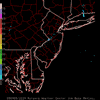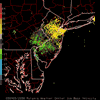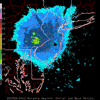Tonight marks the largest flight over New Jersey this spring! Last night’s radar was ablaze with migration across the entire central flyway, from Texas to the Great Lakes. With the wind switch to the south early this morning, and the relatively clear sky, tonight is the night for the Northeast. This pattern is typical this time of year, as we see frontal systems move west to east across the country.
Here is tonight’s radar from sunset until midnight:
The radar shows a very large migration event beginning just after sunset (look for the line of radar in the sixth frame, running from west to east on the western edge of the animation, this is the signal from the sun falling below horizon) and increasing through midnight.
and Here’s the velocity data from the same period:
The velocity plot shows movement across the radar in a general Southwest to Northeast direction at 20 – 25 kts., whereas the actual wind speed at midnight was only around 2kts. This pattern is very indicative of nocturnal bird migration since birds migrate at speeds 20+ kts above the prevailing tailwind (but commonly less than 20+, in the case of a cross or headwind).
What does this mean for birding?
Since there is no precipitation predicted for tonight, birds will be dispersed across the landscape at sunrise. Therefore it is best to visit your favorite spring migrant trap and see what early migrants may show up. Tomorrow’s forecast is similar to tonight, so a new influx (albeit probably less) is expected Thursday morning as well.
good birding!
David
also, check out the nationwide composite of all weather stations at midnight tonight: click here to view (yes, those are the entire eastern and central flyways lit up like Christmas)
***
Morning Update:
Here’s the radar from midnight last night until sunrise this morning:
Birding around Somerset was average to good this morning. The regulars are still around; lots of White-throated and Song Sparrows, Dark-eyed Juncos, Chickadees, Titmice, Golden-crowned Kinglets, and Goldfinches. Also seemingly more abundant today are Common Grackle, Brown-headed Cowbird, Field Sparrow (singing their heads off), Eastern Towhee, Hermit Thrush (a group of 4 working the forest leaf litter, plus a 5th in the cedars), Flicker, and Tree Swallow. An interesting sighting of note was a pair of Great Horned Owls.


